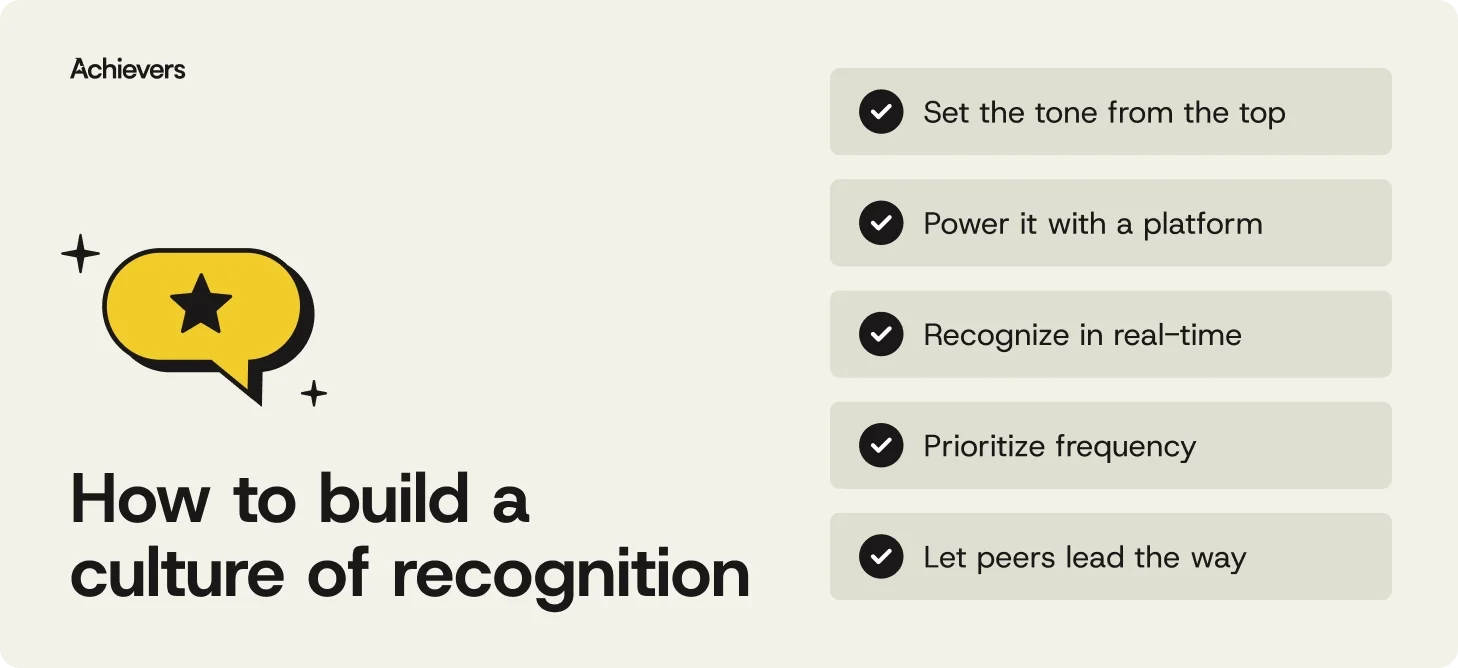Table of contents
Create a culture that means business™
Schedule a demo with an Achievers solution expert today.
A culture of recognition isn’t about pizza parties or the occasional shoutout at the all-hands. It’s about shaping the behaviors that keep your business moving forward — consistently, meaningfully, and at every level.
But in 2025, recognition is quietly slipping through the cracks. According to the State of Recognition Report, weekly recognition dropped by a full 10% in just one year. And manager recognition? It’s down from 20% to 15%.
That matters. Because when recognition disappears, so does clarity, motivation, and connection.
A real culture of recognition doesn’t just happen — it’s built. It takes intention, systems, and the right signals from leadership. And while there’s no one-size-fits-all formula, there is a playbook for getting it right.
Let’s dive in.
11 ways to build a culture of recognition
A strong culture of recognition doesn’t just happen on its own. It takes intention and a few smart systems to back it up.
When recognition becomes part of the way your company works, not just something you talk about at the next team meeting, that’s when things shift. People feel seen. Behaviors get reinforced. Teams work better together.
These strategies can help you build a recognition culture that actually sticks. One that’s easy to take part in, grounded in your values, and built for the long haul.

1. Set the tone from the top
If leadership doesn’t recognize, recognition won’t scale. It’s that simple.
Employees look to leaders to model the culture — and if recognition isn’t part of the everyday vocabulary at the top, it won’t be at the bottom either. When executives and managers make appreciation a habit, it sends a clear message: recognition matters here. And everyone’s expected to take part.
2. Power it with a platform
Recognition can’t just “happen when it happens.” Without a system behind it, it’s inconsistent, invisible, and easy to forget.
A recognition platform gives your people the tools they need to show appreciation in the moment — across teams, time zones, and tools. Look for one that integrates into the flow of work and supports global, points-based reward systems with real choice. Bonus points for usage rates that don’t drop off after launch.
3. Recognize in real time
Recognition loses power the longer you wait. So does vagueness.
“Nice work” doesn’t tell employees much. Instead, call out the exact behavior and explain why it mattered. Recognition that’s specific and timely does more than boost morale; it helps people understand what to repeat and reinforces the values your business runs on.
4. Prioritize frequency
Most people aren’t recognized often enough — and they feel it. While recognition is on the decline across workplaces, data from Achievers Workforce Institute tells us that 91% of employees who are meaningfully recognized at least monthly say they’re very engaged. That’s a stat worth paying attention to. The more frequently recognition happens, the more it reinforces the behaviors you want to see.
5. Let peers lead the way
Managers can’t see everything. But peers? They’re in the trenches.
Peer-to-peer recognition builds trust and connection across teams — especially in hybrid or remote settings. Give employees an easy, visible way to appreciate each other. The best platforms embed right into Slack, Teams, and Outlook, so peer praise is just a click away.
6. Personalize the experience
Recognition isn’t one-size-fits-all. And neither are rewards.
Some people want the spotlight. Others prefer a private note. One person might redeem for a coffee run; another might save up for noise-cancelling headphones. A flexible points-based system lets employees choose what recognition looks like for them — and that choice makes it stick.
7. Connect recognition to what matters most
Recognition shouldn’t float in a vacuum. When you tie it to a company value, team goal, or key result, it becomes more than a pat on the back — it becomes a moment where everyone is in sync.
This helps employees see how their efforts drive impact and gives leaders a clear way to reinforce what matters. The more your recognition connects to strategy, the more it fuels the culture you’re trying to build.
8. Make inclusion part of the design
Recognition shouldn’t favor the loudest voice in the room.
To build a sense of belonging at work, make sure appreciation reaches every employee — across functions, geographies, and lived experiences. Celebrate all the ways people drive impact, not just the most visible wins. Recognition that’s inclusive is recognition that builds trust.
9. Keep it visible
Out of sight, out of culture.
Recognition should be reinforced often — in team meetings, 1:1s, onboarding, and performance conversations. It’s not enough to say it matters. You have to show it, regularly. That repetition turns recognition into a shared habit, not a leadership initiative.
10. Make it a part of how people work
If employees have to leave their workflow to recognize someone, odds are they won’t do it often.
That’s why the best programs integrate directly into tools like Slack, Teams, Outlook, and Workday. When recognition is a part of how teams work every day, it becomes frictionless, natural, and far more consistent across roles and regions.
11. Listen, learn, and adapt
You can’t improve what you don’t track.
Use feedback tools to find out what’s working and what’s missing. Then layer in platform data — recognition frequency, activation rates, reward redemptions — to get a full picture. Recognition cultures don’t stand still, and your strategy shouldn’t either.
The importance of a culture of recognition
A strong culture of recognition is one of the most practical things you can do to keep your people engaged, your teams aligned, and your top performers off LinkedIn.
Because when employees feel genuinely appreciated, they don’t just feel good — they do good. Recognition creates momentum. It tells people, this matters, and gives them a reason to keep doing it. And over time? It changes how your organization works.
Here’s what a culture built on recognition makes possible:
- Higher engagement and better performance: When people know their work is being noticed, they tend to keep doing more of it. Funny how that works.
- Stronger retention: Employees who feel recognized are less likely to ghost you for another offer. It’s harder to leave a place where your contributions actually count.
- Better collaboration: A little appreciation goes a long way in building trust. Teams that recognize each other regularly tend to work better together — fewer silos, more shared wins.
- More innovation and knowledge sharing: Recognition builds psychological safety. And when people feel safe, they speak up — with new ideas, fresh thinking, and solutions you didn’t see coming.
Make recognition a core part of your company culture
Building a culture of recognition takes two things: motivation and the means. Achievers gives you both.
Our platform lets employees show appreciation in real time — from anywhere, on any device. Whether it’s a peer-to-peer shoutout or manager-led praise, recognition becomes easy, visible, and scalable. And with access to a global rewards marketplace featuring 2,500+ brands and 3M+ items (no markup, ever), every moment of appreciation carries real meaning.
Pair that with our Voice of Employee solution, and you’ve got the tools to act on feedback, close the loop fast, and keep your culture evolving with your people — not in spite of them.
The result? A seamless, insight-powered experience that helps you recognize the right behaviors, inspire real connection, and turn everyday appreciation into lasting impact.




